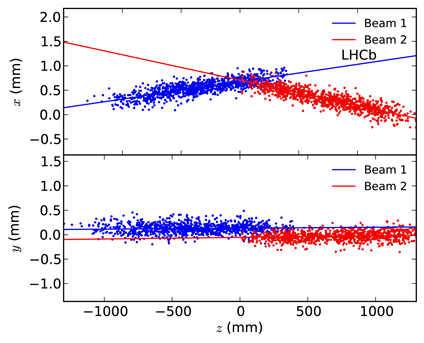LHCb has the most precise answer.
The LHCb Collaboration has just published the results of the luminosity calibration with a precision of 1.12%. This is the most precise luminosity measurement achieved so far at a bunched-beam hadron collider (see below).
At the beginning of operation of a new particle collider, physicists start with measurements of probabilities of different physical processes and compare results with theoretical predictions. Differences may indicate signs for new physics or needs for an improved understanding at higher energies of already known processes. The probabilities are measured as the so called “cross-sections”, σ, in units of area. The number of events N measured in an experiment depends on the value of cross-section σ (given by the nature of the physical interaction) and on a collider parameter luminosity L, N=σL . The luminosity L depends on the number of particles in each collider beam per unit of time and on the size of overlap of both beams at the collision point.
The formula N=σL indicates that the luminosity can be obtained from a measurement of a process for which the cross-section can be calculated with high precision. In this way a precision of few x 10-4 was achieved at the e+ e– collider LEP from the measurement of e+ e– small angle scattering process whose rate was calculated precisely using QED theory. Cross-section predictions with similar or better precision are not available for proton-proton collisions. Therefore, purely experimental methods of luminosity measurements are used at the LHC. The number of particles in each colliding beam per unit of time (so called beam currents) are measured using LHC equipment. Two methods are used to measure the size of overlap of both beams at the collision point.
(1) The van der Meer scans (VDM) method, invented in 1968 by Simon Van der Meer, 1984 Nobel Prize winner, to measure luminosity in the Intersecting Storage Rings (ISR) at CERN, the world’s first hadron collider. The idea was to measure the beams’ overlap by scanning them across each other and monitoring the interaction rate. This method has been used by all four LHC experiments.
(2) The Beam-Gas Imaging (BGI) method was proposed by LHCb physicist Massimiliano Ferro-Luzzi in 2005. It takes advantage of the excellent precision of the LHCb Vertex Locator (VELO) placed around the proton-proton collision point. The BGI method is based on reconstructing vertices of interactions between beam particles and residual gas nuclei in the beam vacuum in order to measure the angles, positions and shapes of the individual beams without displacing them. This allows one to actually see the trace of the beams. To this date only the LHCb Collaboration is capable of using the BGI method.
The image shows the reconstructed positions of proton-beam-gas collision points. It is clearly seen that the proton beams are crossing at an angle. This is intentional since the protons in LHC are not continuously distributed around the ring but are concentrated in 1380 small regions called bunches (so the LHC is a bunched-beam collider). Colliding with an angle and not head-on assures that there are no unwanted collisions between bunches outside the region defined by the experiment. The luminosity was calibrated during special measurement periods and then relative changes were tracked by changes of counting rate of different sub-detectors. The vacuum pressure in the LHC was so low, that in order to increase the proton-beam-gas collision rate, LHCb physicists injected neon gas into the LHC vacuum tube during luminosity calibration periods.
Using the beam-gas data, LHCb physicists were able to reveal that a small fraction of the beam charge is spread outside the expected (i.e. “nominal”) bunch locations. Since only collisions of protons located in the nominal bunches are included in physics measurements, it was very important to measure which fraction of the total beam current value measured with the LHC equipment participated in the collisions (i.e. contributed to the luminosity). Only LHCb could measure this fraction with sufficient precision and, therefore, the results of LHCb measurements of the charge fraction outside nominal bunch locations, called the “ghost” charge, were also used by the three other LHC experiments.
For proton-proton interactions at 8 TeV a relative precision of the luminosity calibration of 1.47% was obtained using van der Meer scans and 1.43% using beam-gas imaging, resulting in a combined precision of 1.12%. This represents the most precise luminosity measurement achieved so far at a bunched-beam hadron collider.
The LHCb BGI method was so successful that LHC engineers decided to use it also for the beam size measurements necessary for monitoring LHC operation. Dedicated equipment is now being built and will soon be installed in a specially modified region of the LHC ring. The equipment includes also a gas injection system.
The LHCb Collaboration is very well armed to measure precisely cross-sections of different processes at 13 TeV proton-proton collisions after the LHC restart in spring 2015.
Read more in the LHCb publication here and in the CERN Courier article.<>

